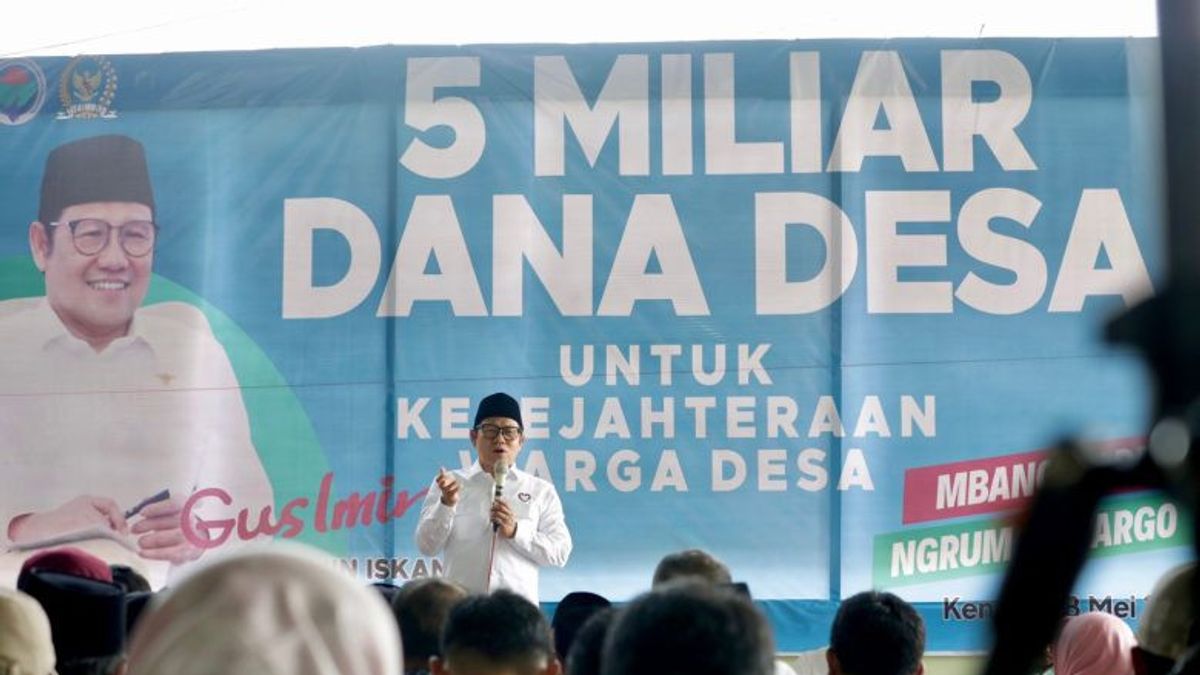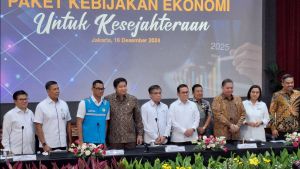JAKARTA The idea of adding village funds to Rp5 billion is considered too popular and the benefits are still doubtful, according to an economist. But on the one hand, this discourse is also considered possible to increase productivity in the village.
The idea of raising village funds to Rp5 billion is the promise of vice presidential candidate number 1 Muhaimin Iskandar if he wins the 2024 Presidential Election (Pilpres).
"If I and Mas Anies win, God willing, there will be drastic changes in the management of state assets and assets for accelerating the country's prosperity. In 2023, Rp2 billion has been successful, God willing, in 2024 each village can reach Rp5 billion per village," said the man who is familiarly called Cak Imin when giving a speech at the gathering with Kiai and Mrs. Nyai throughout West Central Java at the Al-Aqobah Tebuireng Islamic Boarding School, East Java, last September 10.
Muhaimin Iskandar believes that Indonesia has an abundant State Revenue and Expenditure Budget (APBN). Therefore, the Rp5 billion fund is not excessive to advance the village economy.
Cak Imin's program provides village funds of up to IDR 5 billion, from the previous IDR 2 billion, of course it raises questions from many parties. From an economist point of view, Cak Imin's promise is rather difficult to realize, there is the potential for leakage of funds, and not necessarily the benefits of the village community.
However, the political point of view, spreads a sweet promise to attract the attention of voters is normal. After all, when these ideas have been chosen, they can be billed by the people.
The discourse on adding village funds to Rp5 billion per village in 2024 has actually been disclosed by Muhaimin Iskandar when he was still Deputy Chairman of the Indonesian House of Representatives for the Coordinator of People's Welfare (Korkesra). The success of the majority of village heads (kades) in managing village funds was motivated by Cak Imin's idea.
Cak Imin did not turn a blind eye to the potential for misappropriation of funds, but according to him, raising village funds could make Indonesia progress more quickly.
The man who was born on September 24, 1966, said it was time for the national development strategy to be changed from the previous top down to the bottom up or from the village. He is also optimistic that village funds of IDR 5 billion per village will intensify development not only in every village, but also on a national scale.
Then in early November, the Indonesian Village Apparatus Association Management Board (DPN PPDI) met President Joko Widodo at the Presidential Palace. They propose that the village fund budget be increased to IDR 5 billion per village per year.
Like a tit for tat, the idea was agreed by the Minister of Villages, Development of Disadvantaged Regions, and Transmigration, Abdul Halim Iskandar, who is the older brother of Muhaimin Iskandar. He believes that the village fund of IDR 5 billion per year will be granted by the government in order to create an independent village.
This super luxury discourse attracted the attention of many parties, including the Chairman of the All-Indonesian Village Government Association (APDESI), Arifin Abdul Majid, who welcomed positively. But on the one hand he is also realistic because the funds needed are very large.
"We welcome if indeed village funds increase to Rp5 billion per year. With the increase in village funds, the value of increased performance, and development in villages will also be even greater," said Arifin to VOI.
"Then I calculated to professionals, where did the rational funds come from?" he added.
In the previous year, Arifin said that from the APBN, IDR 73 trillion was provided for around 74 thousand villages spread throughout Indonesia. This means that the average village fund is around Rp. 1 billion per year. The budget for village funds will increase drastically to Rp. 400 trillion if increased to Rp. 5 billion per village per year.
"The rational value, where did this fund come from? While in 2024 there will be funds for the election? Which funds should be taken for village funds that are less than IDR 350 trillion?" Arifin explained.
"We don't understand this part. Because seeing the numbers is extraordinary, but not rational. That means the increase is almost 500 percent," Arifin added.
SEE ALSO:
The idea of village funds rising to Rp5 billion per village per year emerged in the political year, ahead of the 2024 Presidential Election (Pilpres) and was promoted by one of the contestants, namely Muhaimin Iskandar.
Arifin did not deny the opportunity that this discourse was part of a political strategy. But he really hopes that the idea of Rp5 billion village funds will be realized, aka not just promises.
"If you want to be associated with elections, it's possible that it exists because it is now a political year. If this is a tactic from one of the pairs or political parties, I think it's legal," he said.
"But is it rational to catch up or not? Don't let the election finish, it turns out to be just a plan."
Too populist. This was stated by the Director of the Center of Economic and Law Studies (CELIOS), Bhima Yudhistira when asked for her opinion regarding the idea of a village fund of IDR 5 billion disclosed by Muhaimin Iskandar.
Bhima explained a number of reasons why additional village funds were still not needed. First, not all villages are currently able to optimally absorb village funds. Even village funds that have been issued or have not been realized 100 percent in 2022 are still there.
"If the budget is added, we are worried that the quality of spending will be low and village officials will be forced to spend the budget on programs that are not needed by the community," said Bhima when contacted by VOI.
"Yes, it is better to check the effectiveness of the village fund program again and as much as possible to sharpen and reallocate funds rather than increase village funds," he added.
The second reason why additional village funds have not been needed is because according to Bhima, the supervision of village funds is still far from perfect. He is worried that the addition of the budget could actually trigger massive corruption in village funds. Throughout 2022, the most corruption is at the village level.
Finally, Bhima sees the challenges of fiscal conditions going forward. These challenges start from increasing the burden on government bureaucratic costs, including spending on employees and goods, spending on debt interest to spending on subsidies.
"The addition of village funds helped widen the scenario of the budget deficit," explained Bhima.
"So don't just be populist because you want an election and then promise to increase village funds, there will be minimal effectiveness and supervision, it can be leaked here and there and the village community will not necessarily benefit," Bhima added.
Contacted separately, a political observer from Al-Azhar University Indonesia, Andriadi Achmad said, the idea of village funds to become Rp5 billion cannot be denied as one of the ways for pair number 1 to win public votes ahead of the 2024 presidential election on February 14.
The sweet promises made by the presidential candidates throughout the campaign time are common. Andriadi said the idea must have been calculated and reviewed by the success team of the Anies Baswedan-Muhaimin Iskandar pair. In practice, the public only needs to collect the promises that have been announced during this campaign.
"This is one way to capitalize on votes from the village," said Andriadi when contacted by VOI.
"Whatever has been issued by the presidential candidates must be recorded by the public and later they will just be billed when elected," Andriadi added.
Based on data from the Directorate General of Fiscal Balance (DJPK) of the Ministry of Finance, the allocation of village funds this year is IDR 70 trillion. The funds are allocated for 74,954 villages in the country. The amount of village funds received by each village is regulated in the Minister of Finance Regulation (PMK) Number 201 of 2022.
From the attachment to PMK document Number 201 of 2022, the lowest village funds received by each village are in the range of Rp. 500 million. However, there are also villages that receive funds of more than Rp. 2 billion. For example, Sukaraya Village with an allocation of Rp. 2.33 billion and Babelan Village, Kota Rp. 2.26 billion. Both are in Bekasi Regency, West Java.
The English, Chinese, Japanese, Arabic, and French versions are automatically generated by the AI. So there may still be inaccuracies in translating, please always see Indonesian as our main language. (system supported by DigitalSiber.id)














